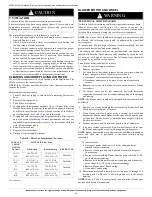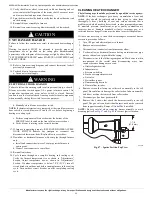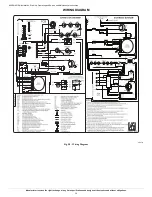
800SA/801SA: Installation, Start–Up, Operating and Service and Maintenance Instructions
Manufacturer reserves the right to change, at any time, specifications and designs without notice and without obligations.
21
U.S.A.
— Refer to Sections 13.1.8 and 13.2.20 of the current edition of NFGC
NFPA54/ANSI Z223.1 or the authority having jurisdiction to determine whether
relining is required. If relining is required, use a properly sized listed metal liner,
Type-B vent, or a listed alternative venting design.
NOTE:
See the current edition of NFPA54/ANSI Z223.1, 13.1.8 and
13.2.20 regarding alternative venting design and the Exception, which
cover installations such as the Chimney Adapter Kits, which are listed
for use with these furnaces. See Product Data Sheet for accessory
listing.
The Chimney Adapter Kit is listed alternative venting system for these
furnaces. See the kit instructions for complete details.
This furnace is permitted to be vented into a clay tile-lined masonry
chimney that is exposed to the outdoors below the roof line, provided:
1. Vent connector is Type-B double-wall, and
2. This furnace is common vented with at least 1 draft hood equipped
appliance, and
3. The combined appliance input rating is less than the maximum
, and
4. The input rating of each space heating appliance is greater than the
minimum input rating given in
Design Temperature. Chimneys having internal areas greater than
38 square inches require furnace input ratings greater than the input
ratings of these furnaces. See footnote at bottom of
, and
5. The authority having jurisdiction approves.
If all of these conditions cannot be met, an alternative venting design
shall be used, such as the listed chimney adapter kit with these furnaces,
which are listed for use with the kit, a listed chimney-lining system, or a
Type-B common vent.
*The 99.6% heating db temperatures found in the 1997 or 2001 ASHRAE Fundamentals
Handbook, Climatic Design Information chapter, Table 1A (United States) or the 2005
ASHRAE Fundamentals handbook, Climatic Design Information chapter, and the CD-ROM
included with the 2005 ASHRAE Fundamentals Handbook.
WARNING
!
CARBON MONOXIDE POISONING HAZARD
Failure to follow the steps outlined below for each appliance connected
to the venting system being placed into operation could result in carbon
monoxide poisoning or death.
The following steps shall be followed for each appliance connected to
the venting system being placed into operation, while all other
appliances connected to the venting system are not in operation:
1.Seal any unused openings in venting system.
2.Inspect the venting system for proper size and horizontal pitch, as
required in the current edition of National Fuel Gas Code, ANSI
Z223.1/NFPA 54 and these instructions. Determine that there is no
blockage or restriction, leakage, corrosion and other deficiencies,
which could cause an unsafe condition.
3.As far as practical, close all building doors and windows and all doors
between the space in which the appliance(s) connected to the venting
system are located and other spaces of the building.
4.Close fireplace dampers.
5.Turn on clothes dryers and any appliance not connected to the venting
system. Turn on any exhaust fans, such as range hoods and bathroom
exhausts, so they are operating at maximum speed. Do not operate a
summer exhaust fan.
6.Follow the lighting instructions. Place the appliance being inspected
into operation. Adjust the thermostat so appliance is operating
continuously.
7.Test for spillage from draft hood equipped appliances at the draft
hood relief opening after 5 minutes of main burner operation. Use the
flame of a match or candle.
8.If improper venting is observed during any of the above tests, the
venting system must be corrected in accordance with the current edition
of National Fuel Gas Code, ANSI Z223.1/NFPA 54.
9.After it has been determined that each appliance connected to the
venting system properly vents when tested as outlined above, return
doors, windows, exhaust fans, fireplace dampers and any other
gas-fired burning appliance to their previous conditions of use.
Table 8 – Combined Appliance Maximum Input Rating
in Thousands of Btuh per Hour
VENT HEIGHT
FT. (M)
INTERNAL AREA OF CHIMNEY
IN
2
(MM
2
)
12
(7741)
19
(12258)
28
(18064)
38
(24516)
6 (1.8)
74
119
178
257
8 (2.4)
80
130
193
279
10 (3.0)
84
138
207
299
15 (4.5)
NR
152
233
334
20 (6.0)
NR
NR
250
368
30 (9.1)
NR
NR
NR
404
Table 9 – Minimum Allowable Input Rating of Space-Heating
Appliance in Thousands of Btuh per Hour
VENT HEIGHT
FT (M)
INTERNAL AREA OF CHIMNEY
IN
2
. (MM
2
)
12
(7741)
19
(12258)
28
(18064)
38
(24516)
Local 99% Winter Design
Temperature: 17 to 26°F (-8 to -3°C)
6 (1.8)
0
55
99
141
8 (2.4)
52
74
111
154
10 (3.0)
NR
90
125
169
15 (4.6)
NR
NR
167
212
20 (6.1)
NR
NR
212
258
30 (9.1)
NR
NR
NR
362
Local 99% Winter Design
Temperature: 5 to 16°F* (-15 to -9°C)
6 (1.8)
NR
78
121
166
8 (2.4)
NR
94
135
182
10 (3.0)
NR
111
149
198
15 (4.6)
NR
NR
193
247
20 (6.1)
NR
NR
NR
293
30 (9.1)
NR
NR
NR
377
Local 99% Winter Design
Temperature: -10 to 4°F* (-23 to -16°C)
6 (1.8)
NR
NR
145
196
8 (2.4)
NR
NR
159
213
10 (3.0)
NR
NR
175
231
15 (4.6)
NR
NR
NR
283
20 (6.1)
NR
NR
NR
333
30 (9.1)
NR
NR
NR
NR
Local 99% Winter Design
Temperature: -11°F (-24°C) or lower
Not recommended for any vent configuration.
















































